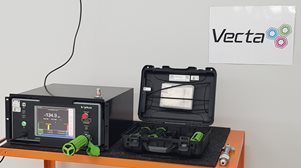Kaelus ACE Calibration Extender enables Vecta Labs to achieve world first accreditation
APR 27, 2022
in April 2021, In partnership with Kaelus, Vecta Labs became the first test laboratory in the world to achieve the ISO 17025 accreditation for electrical test methods in Passive RF and Microwave Devices intermodulation level measurement (PIM); (A2LA accredited, certificate number 5367.01). At the same time, Vecta Labs was also accredited for Return Loss (uniformity of impedance), Insertion Loss and Isolation measurements.
To be considered an ISO17025 accredited laboratory, all test instruments used must be able to be traced back to an international standard. Under normal circumstances, these requirements would be complicated, but wouldn’t cause significant problems.
However, as Vecta Labs was seeking accreditation for PIM measurement, the process became infinitely more complex. This had never been achieved before.
|
To achieve accreditation, Vecta Labs engaged the Kaelus ACE Calibration Extender, which ensured traceability of PIM testing to an internationally accredited standard.
It was through this partnership and use of technology that Vecta Labs was able to become the first lab testing facility globally that met the ISO 17025 accreditation standards for PIM measurement.
|
 |
To better understand the process of becoming ISO 17025 accredited and how the ACE Calibration Extender tool was used to assist this process, Kaelus spoke with Vecta Labs.
See our Q&A with Vecta Labs’ General Manager, Darren Webster, and Principal R&D Engineer, Brendan Horsfield below:
What is ISO 17025 and what does it mean (in the context of equipment calibration) to be ISO 17025 certified?
Brendan: ISO 17025 is an international standard used by testing and calibration laboratories to demonstrate technical competence in their field of interest. It is a comprehensive standard, which encompasses all aspects of a laboratory’s operation. It considers everything from the management structure and distribution of authority, down to the fine details of the testing procedures used by technical staff.
Darren: One of the most important considerations for an ISO 17025 accredited laboratory is the establishment of a traceable calibration process for all test instruments. This ensures that test results produced by the laboratory can be traced back to an international standard.
When it comes to PIM (passive intermodulation) measurements, metrological traceability is very difficult to prove and to gain the ISO17025 accreditation, we had to show compliance.
What made you decide to use ACE as the calibration hardware?
Darren: The ACE Calibration Extender from Kaelus was the solution that allowed us to overcome the challenges of proving metrological traceability for PIM, which stemmed from the fact that stable, ISO 17025 accredited verification standards for PIM Analysers are not commercially available.
Brendan: ACE features that allowed us to overcome these challenges and secure the ISO7025 accreditation include:
- ACE standards are characterized in Kaelus’ factory using instruments that have themselves been calibrated in a traceable manner. This ensures that the characterization data for the ACE standards is also traceable.
- ACE standards contain temperature sensors to ensure the calibration is performed within consistent temperature limits.
- The ACE kit contains a redundant copy of each standard. This provides a safeguard against “false failures” in the event that one standard develops a fault.
- Results of ACE calibrations are cross-checked against historical data to monitor long-term drift in the RF properties of the standards from their original factory states.
- ACE calibration process is remotely controlled by Kaelus’ cloud server, which greatly reduces the risk of operator error.
- Each ACE kit is compatible with PIM Analysers from multiple frequency bands
- ACE calibrations can be performed as often as desired for no extra charge.
For these reasons, the Analyzer Calibration Extender (ACE) system has become the cornerstone of Vecta Lab’s PIM Analyser calibration process.
What is the biggest benefit of using ACE?
Brendan: For a high-volume test laboratory-like Vecta Labs, the biggest benefit of using ACE is that PIM Analyser calibrations can be performed in-house. This greatly reduces downtime, as there is no need to ship our instruments back to a Kaelus service center for calibration.
Most companies only calibrate their PIM instruments on a yearly basis. How many times per year to you calibrate your instrument, and (if more than once a year), what is the benefit of doing so?
Darren: At Vecta Labs we normally calibrate our PIM Analysers once annually, per the manufacturer’s recommendations. However, some circumstances require us to calibrate more frequently than this. An example of when we will need to calibrate more than once per year is following the relocation of a mobile test chamber to a new site.
Anytime we move a mobile test chamber, we will perform calibration and system verification, as this allows us to confirm the integrity of our equipment was not compromised during the move.
For more information on the Kaelus ACE system, head here.
To find out more about Vecta Labs and how it achieved the ISO 17025 accreditation, visit the Vecta Labs website.
For more information, contact Mark Henderson from Vecta Labs at mark.henderson@vectalabs.com or on
+61 (0)431 465 004.